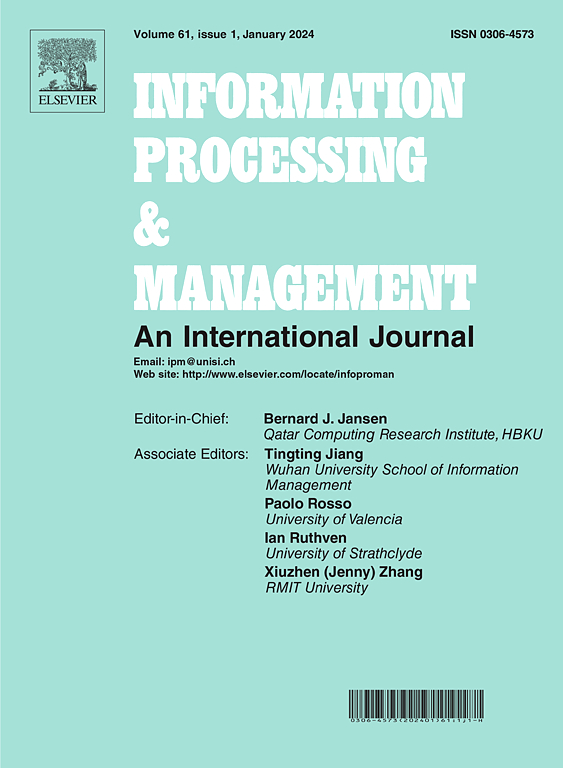EKLI-Attention: An integrated attention mechanism for classifying citizen requests in government‒citizen interactions
IF 6.9
1区 管理学
Q1 COMPUTER SCIENCE, INFORMATION SYSTEMS
引用次数: 0
Abstract
Various regions in China mainland have implemented government‒citizen interaction boards on their government portals. Government staff assign citizen requests from these boards to departments for responses. With increasing request volume and departmental complexity, manual classification is excessively time-consuming and labor-intensive. The study of automatic classification for citizen requests has become more essential. Citizen requests contain governmental terms and limited text content, making them a typical example of short texts. In this study, an integrated attention mechanism model named EKLI-Attention (external knowledge and label information) is proposed to classify citizen requests by introducing external knowledge, such as relevant government matters and administrative region information, with labels corresponding to government departments. Particularly, a single-head cross-attention mechanism is designed to integrate text features with label information and generate an updated label feature representation, whereas a multihead self-attention mechanism is employed to integrate external knowledge to generate an updated text representation. Finally, multi-head cross-attention and two-stage convolution combine the updated label and text representations to generate the final classification. In the case study, two datasets containing over 84,000 citizen requests from Beijing and Shenzhen are investigated. The models are found to outperform the baseline models in various evaluation metrics, demonstrating their effectiveness and robustness. The application of Focal Loss improves the macro F1 score by 3.47 % and 4.04 % on the two datasets. It improves the efficiency of government agencies by ensuring that requests are routed to the correct departments efficiently. Moreover, it provides a valuable technical reference for short text classification.
EKLI-Attention:政府-公民互动中公民请求分类的集成注意机制
中国大陆的许多地区都在政府门户网站上设立了政府与公民互动板。政府工作人员将市民向这些委员会提出的要求分配给各部门,以便作出回应。随着请求量的增加和部门复杂性的增加,人工分类过于耗时和费力。对公民请求自动分类的研究已变得越来越必要。公民请求包含政府术语和有限的文本内容,是典型的短文本。本研究提出了一种集成关注机制模型EKLI-Attention(外部知识和标签信息),通过引入相关政府事项、行政区域信息等外部知识,并将其与政府部门相对应的标签,对公民请求进行分类。其中,设计了单头部交叉注意机制,将文本特征与标签信息整合,生成更新的标签特征表示;设计了多头部自注意机制,整合外部知识,生成更新的文本表示。最后,多头交叉注意和两阶段卷积结合更新的标签和文本表示来生成最终的分类。在案例研究中,我们调查了两个数据集,其中包含来自北京和深圳的84,000多个公民请求。发现模型在各种评价指标上优于基线模型,证明了它们的有效性和鲁棒性。在这两个数据集上,焦损的应用使宏观F1分数分别提高了3.47%和4.04%。通过确保请求被有效地传送到正确的部门,它提高了政府机构的效率。为短文本分类提供了有价值的技术参考。
本文章由计算机程序翻译,如有差异,请以英文原文为准。
求助全文
约1分钟内获得全文
求助全文
来源期刊

Information Processing & Management
工程技术-计算机:信息系统
CiteScore
17.00
自引率
11.60%
发文量
276
审稿时长
39 days
期刊介绍:
Information Processing and Management is dedicated to publishing cutting-edge original research at the convergence of computing and information science. Our scope encompasses theory, methods, and applications across various domains, including advertising, business, health, information science, information technology marketing, and social computing.
We aim to cater to the interests of both primary researchers and practitioners by offering an effective platform for the timely dissemination of advanced and topical issues in this interdisciplinary field. The journal places particular emphasis on original research articles, research survey articles, research method articles, and articles addressing critical applications of research. Join us in advancing knowledge and innovation at the intersection of computing and information science.
 求助内容:
求助内容: 应助结果提醒方式:
应助结果提醒方式:


